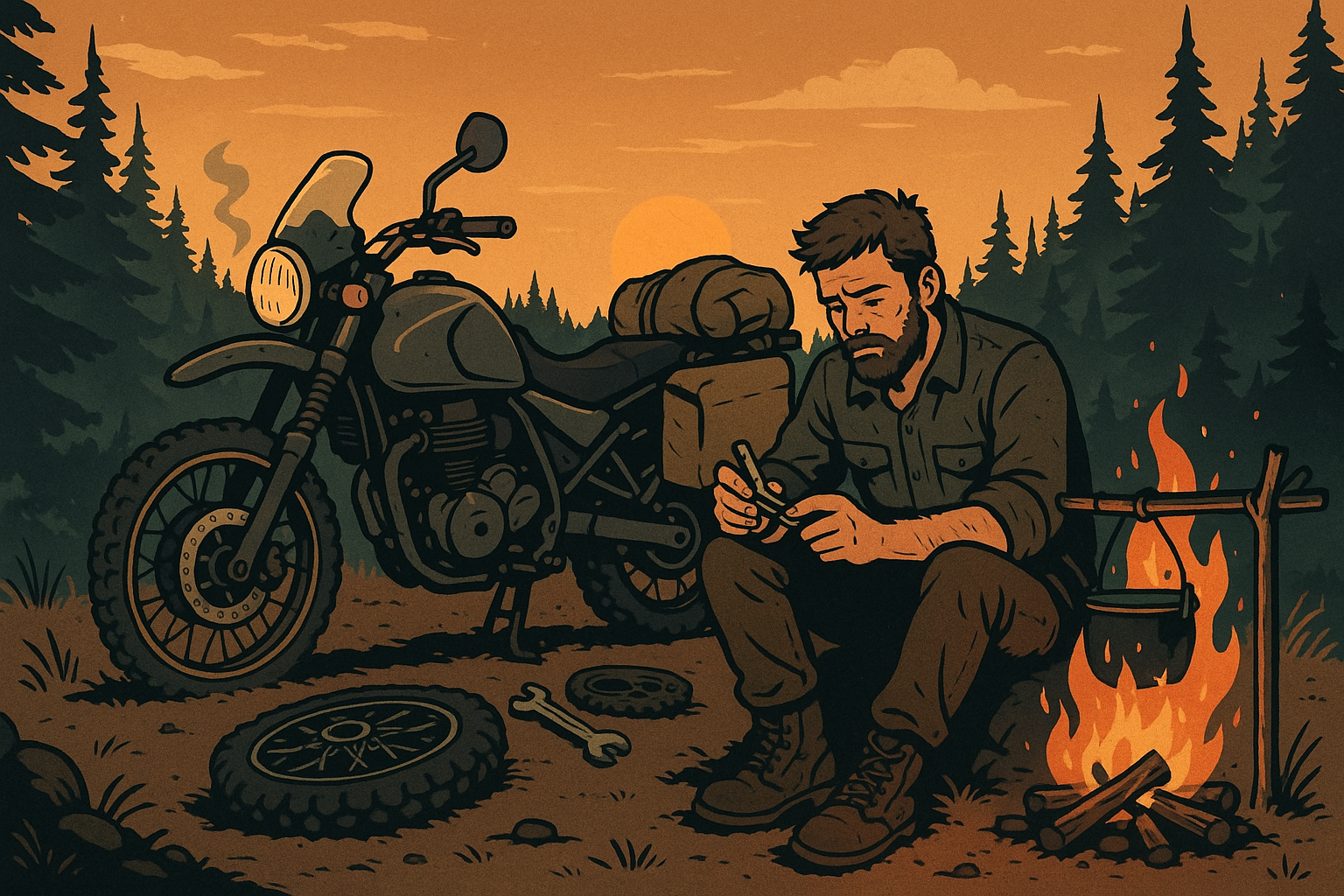The engine coughs.
The wheels lock.
The silence feels louder than the forest around you.
Stranded. No cell service. No help on the way.
This is the reality every motorcycle camper dreads —
but it doesn’t have to end badly.
With a few smart survival hacks, you can stay alive, signal for help, or even walk out safely with your gear intact.
Here’s 7 survival hacks that could save your life when your motorcycle leaves you stranded in the wild.
1. Turn Your Motorcycle Into a Shelter Anchor Point
Reality:
When your bike is dead, it’s not useless — it becomes part of your survival shelter.
Here’s how:
- Use your bike as a windbreak by parking it across the dominant wind direction.
- Stretch a tarp, poncho, or tent fly from the bike to the ground to create a fast lean-to shelter.
- Lash lines from the bike’s handlebars, rear rack, or crash bars for rapid tension points.
Bonus Trick:
The engine and gas tank retain heat for hours after shutting off —
If safe, sleep close (but not against) the bike to harvest this radiant warmth.
A dead machine can become your best ally if you think differently.
2. Emergency Fuel Hacks: Cook, Signal, or Stay Warm
If you’re stranded, your motorcycle’s fuel is emergency survival gold.
Use it carefully:
- Fuel for Fire:
Dip a small cloth in gasoline (sparingly) and ignite it to start a survival fire under wet conditions. One soaked rag = minutes of flame. - Fuel for Cooking:
Siphon small amounts into a multi-fuel survival stove. - Fuel for Signal Fires:
(In extreme rescue scenarios) pour a small ring on clear ground and ignite to produce a smoke flare visible for miles.
Field Warning:
Only use small amounts. Fumes are explosive. Always light at a safe distance and upwind.
Your motorcycle is carrying survival-grade accelerant — if you know how to tap it.
3. Turn Your Bike’s Mirrors Into Rescue Signaling Devices
Your mirrors aren’t just for lane-checking anymore —
they’re built-in heliographs (signal mirrors).
How to signal for rescue:
- Remove or adjust the side mirror.
- Aim it at the sun.
- Angle flashes toward distant roads, open valleys, or passing aircraft.
Pro Hack:
Make quick, repeated flashes — moving sunlight flashes attract human attention better than a static glare.
If you have no sun, a powerful flashlight aimed at a mirror at night can also create a “flashing beacon.”
Signals move faster than feet — use the gear you already have.
4. Use Your Bike’s Battery for Emergency Lighting or Power
If your motorcycle battery still has charge left —
it’s a survival tool you cannot waste.
Field Hacks:
- Connect small LED camping lights directly to the battery using alligator clips.
- Charge USB devices directly if you have a converter cable.
- Use the headlight or taillight as a high-visibility rescue beacon overnight.
Pro Tip:
If the battery is low, prioritize using it for short bursts of visibility (flashing lights) rather than running continuously until dead.
Bonus:
A flashing taillight is recognizable to searchers — even more than fires.
5. Scavenge Bike Parts to Build Tools or Weapons
If you can’t save the bike, salvage it.
Critical survival scavenging from your bike:
- Cables: Can be stripped to make cordage, traps, lashings.
- Tires: Burn rubber cautiously for massive black smoke (rescue signal).
- Brake lines: Strong enough to act as heavy-duty emergency rope.
- Metal parts: Bash into improvised cutting tools or digging instruments.
Emergency Field Tool:
Brake rotors sharpened against rock = crude cutting blade.
Your dead bike is a gear cache — strip it smartly.
6. Deploy the “Moving Camp” Strategy — Don’t Wait to Die
If after 24–48 hours you are still stranded with no rescue in sight,
you may need to self-rescue on foot — but strategically.
Here’s how to execute it:
- Mark your starting location (bike) clearly: rocks, bright fabric, scratched tree marks.
- Pack the absolute minimum survival kit:
- Shelter
- Water filtration
- Fire starter
- Energy food
- Move during daylight only, following handrails like rivers, ridges, or valleys.
Pro Hack:
Leave visible signs every 100 meters —
If rescuers find your bike later, they can track you more easily along your path.
Survival means movement — but only movement with a plan.
7. Use Bike Fluids as Last-Resort Emergency Materials
When all else fails, the motorcycle itself still holds vital chemical survival resources.
Crisis uses:
- Oil:
- Coat cotton cloth for waterproofing.
- Slow-burning torches for nighttime signaling.
- Coolant:
- Reflective signaling by spreading thinly on dark rocks (shines in moonlight).
- Brake Fluid:
- Burnable in high heat survival fires (use with extreme caution).
Warning:
Most fluids are toxic.
Use only externally for survival tools, not consumption.
Field Rule:
If it’s wet and chemical — it can likely burn, coat, or signal.
🏕 Stranded Survival Quick Strategy:
✅ Anchor your shelter around the bike.
✅ Siphon fuel for emergency fires or stoves.
✅ Flash mirrors toward rescuers.
✅ Stretch battery life for critical lighting.
✅ Scavenge cables, metal, and tools.
✅ Move methodically if rescue doesn’t come.
✅ Repurpose all fluids for fire and signaling.
Your bike isn’t just transport — it’s your field survival base.
🌄 Conclusion: Survival Means Using Everything You Have
A broken motorcycle doesn’t mean a broken survival chance.
If you adapt — if you think beyond “riding” and start building survival from the machine —
you can outlast the weather, find your way out, or be rescued alive.
Remember:
Motorcycles are machines — but survival is human.
And humans adapt.

